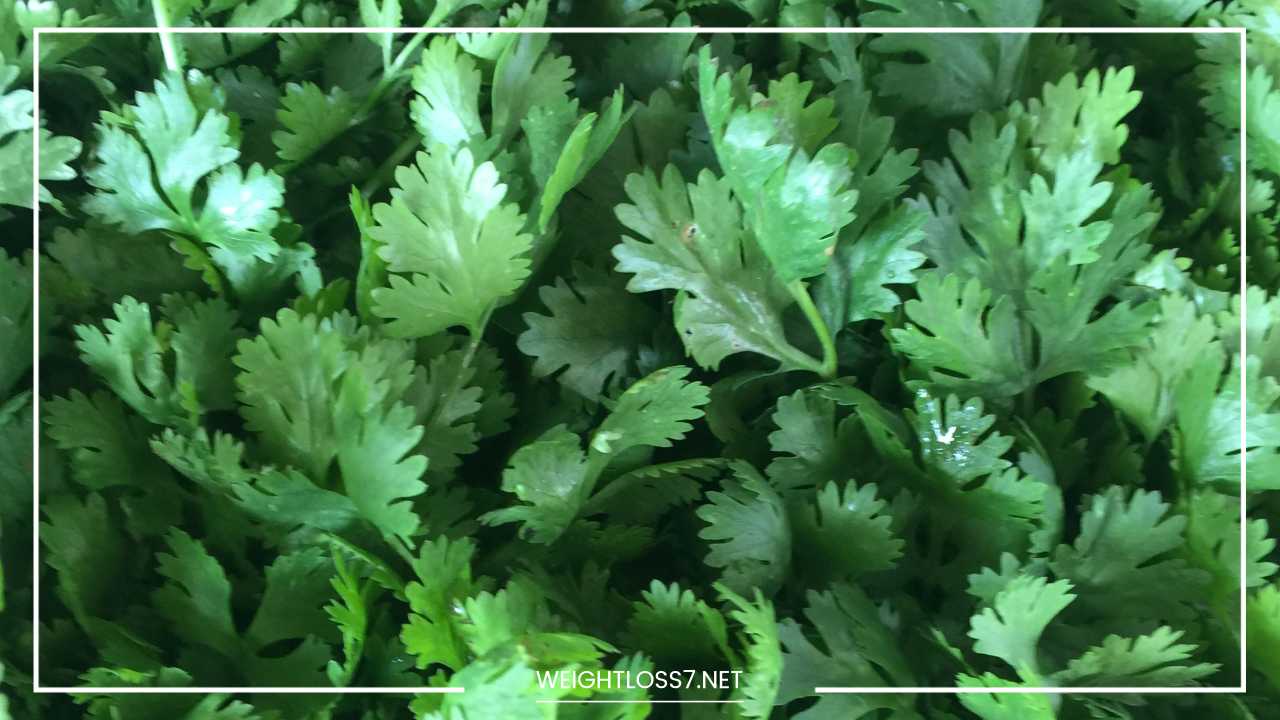Cilantro Uses and Health Benefits

Cilantro
Cilantro: The Flavorful Powerhouse Unveiling Its Hidden Health Benefits
Cilantro, the verdant jewel with a complex flavor profile, transcends its role as a mere garnish. This lacy-leafed herb, also known as coriander leaves, boasts a vibrant history in global cuisine and traditional medicine.
But its journey extends far beyond adding a zesty punch to guacamole or pho. Recent research is unveiling the potential health benefits lurking beneath its citrusy exterior, making cilantro a hidden champion in the realm of wellness.
Aromatic Adventures: Cilantro’s Culinary Canvas
Cilantro’s flavor profile is a captivating dance between citrus and pepper, with subtle floral notes. This unique character makes it a versatile culinary chameleon, seamlessly adapting to a wide range of cuisines.
It’s the lifeblood of Latin American dishes, gracing everything from guacamole and salsa to ceviche and vibrant chimichurri sauce.
Southeast Asian flavors come alive with cilantro’s presence in curries, stir-fries, and the fragrant broth of pho. European and Middle Eastern cuisine embraces cilantro’s vibrancy, adding it to falafel, hummus, and chutneys.
But cilantro’s culinary adventures extend far beyond these well-trodden paths. Here’s how to unlock its potential and transform everyday meals:
- Salad Sensations: Ditch the monotony of plain greens! A sprinkle of chopped cilantro adds a burst of freshness to classic salads, potato salad, or coleslaw.
- Soup and Stew Symphony: Elevate your comfort food game by adding a handful of cilantro leaves near the end of cooking. It brightens flavors without overpowering the existing profile.
- Marinade Magic: Transform your next protein dish with a cilantro-infused marinade. Fish, chicken, or tofu come alive with a vibrant citrusy depth when marinated with chopped cilantro, garlic, olive oil, and a touch of lime juice.
- Dip Delights: Hummus and yogurt dips take on a new dimension with the addition of chopped cilantro. It adds a refreshing touch and complements the richness of these creamy staples.
- Dressing Dreams: Homemade salad dressings and chutneys can be elevated with the vibrant flavors of cilantro. Experiment with different combinations of herbs, spices, and citrus juices to create unique dressings.
- Sandwich Savior: The next time you’re building a veggie burger or a falafel wrap, don’t forget the cilantro. A sprinkle of this herb adds a burst of freshness and cuts through richer flavors.
Beyond the Flavor: Unveiling Cilantro’s Nutritional Powerhouse
Cilantro might seem delicate, but its delicate leaves pack a powerful nutritional punch. A mere quarter cup (around 4 grams) of raw cilantro offers a surprising array of essential nutrients:
- Vitamin K Champion: Cilantro boasts an impressive 16% of the Daily Value (DV) for Vitamin K, crucial for blood clotting and maintaining strong bones.
- Vitamin A Ally: It contributes to healthy vision and a robust immune system by providing a dose of Vitamin A.
- Vitamin C Contributor: This essential antioxidant supports the immune system and promotes collagen production, keeping your skin healthy and youthful.
- Manganese Marvel: Cilantro is a good source of manganese, a mineral necessary for optimal enzyme function and metabolism.
- Potassium Powerhouse: This mineral helps regulate blood pressure and ensures proper muscle function.
- Trace Mineral Treasure Trove: Cilantro also offers small amounts of calcium, iron, and phosphorus, contributing to overall mineral balance.
And the best part? Cilantro is a remarkably low-calorie food, with only about 2 calories per serving. This makes it an guilt-free way to add a boost of flavor and essential nutrients to your diet.
Delving Deeper: Exploring Cilantro’s Potential Health Benefits
The world of scientific research is starting to shed light on the potential health benefits associated with cilantro consumption. While more studies are needed to fully understand the extent of its impact, current research suggests cilantro may play a significant role in:
- Blood Sugar Management: Animal studies have shown promise. Extracts of cilantro appear to help lower blood sugar levels, potentially aiding in diabetes management.
- Heart Health Hero: Cilantro is rich in antioxidants, which may help protect against heart disease by reducing inflammation and fighting free radical damage.
- Brainpower Booster: Some research suggests that cilantro may have neuroprotective properties. This means it could potentially help guard brain health and cognitive function.
- Detoxification Dynamo: Cilantro has traditionally been used to aid in detoxification. Studies indicate that it may help remove heavy metals from the body, although further research is needed to confirm its effectiveness.
- Antibacterial Agent: Cilantro extracts have shown antibacterial properties in laboratory settings. This suggests it could potentially help fight foodborne illnesses caused by bacteria like Salmonella.
Cilantro: A Fragrant Friend with Considerations and Care
Important Considerations: Knowing When Cilantro Might Not Be Right
While cilantro is generally safe for most people to consume in moderate amounts, there are a few things to keep in mind:
- Allergic Reactions: Some people may experience allergic reactions to cilantro, manifesting as skin irritation, swelling, or even breathing difficulties. If you have any known allergies to other plants in the Apiaceae family (like parsley or fennel), it’s best to proceed with caution and consult a healthcare professional before consuming cilantro.
- Taste Perception: The unique flavor profile of cilantro can be a source of debate. Some people adore its citrusy zest, while others find it soapy or unpleasant. This is due to a genetic variation that affects how individuals perceive the taste of aldehydes, a compound present in cilantro. If you fall into the “soapy cilantro” camp, there’s no need to despair! Explore other flavorful herbs to add vibrancy to your dishes.
- Blood Sugar Medication Interactions: Cilantro’s potential blood sugar-lowering effects may interact with medications used to manage diabetes. If you take blood sugar medications, it’s crucial to speak to your doctor before significantly increasing your cilantro intake.
Selecting and Storing Cilantro for Peak Freshness: Keeping Your Herb Vibrant
To get the most out of cilantro’s flavor and potential health benefits, it’s essential to choose the freshest leaves and store them properly. Here are some tips to ensure your cilantro stays vibrant for longer:
- Choosing the Freshest Bunch: Look for cilantro with bright green, unwilted leaves. The stems should be crisp and green, not brown or slimy. Avoid any bunches with yellowing or brown spots on the leaves. A fresh bunch of cilantro should have a pleasant, citrusy aroma.
- Storage Strategies: Once you’ve chosen the perfect bunch, it’s time to store it properly. Cilantro thrives in a cool, humid environment. Wrap the bunch loosely in a damp paper towel and place it in the crisper drawer of your refrigerator. This method can help keep your cilantro fresh for 3-5 days.
- Alternative Storage: For longer storage, consider freezing cilantro. Chop the leaves finely and place them in ice cube trays with a little water. Once frozen, transfer the cilantro cubes to an airtight container and store them in the freezer for up to 3 months. This method is perfect for adding a burst of cilantro flavor to soups, stews, or smoothies without compromising on freshness.
Cilantro: A Culinary and Wellness Companion
Cilantro’s journey extends far beyond its vibrant green presence on your plate. It’s a versatile herb with a rich history, captivating flavor profile, and a range of potential health benefits waiting to be explored.
From adding a zesty touch to your favorite dishes to potentially aiding in blood sugar management and brain health, cilantro is a fragrant friend with a lot to offer.
So next time you’re at the grocery store, pick up a bunch of cilantro and embark on a culinary and wellness adventure with this unique and flavorful herb.
Additional Points to Consider:
- You can explore including a section on incorporating cilantro into various cuisines around the world, providing specific recipe examples.
- Briefly touch upon the history and cultural significance of cilantro in different regions.
- If you find relevant research, you can add a subsection on the potential benefits of cilantro seeds, which are commonly used whole or ground in various spice blends.
Cilantro: A Global Citizen with Culinary Flair and Functional Benefits
A Journey Through Cilantro’s Global Influence
Cilantro’s vibrant presence transcends borders and cultures. Its journey as a culinary and medicinal herb stretches back millennia, leaving its mark on cuisines around the world. Here’s a glimpse into cilantro’s global influence:
- Latin American Delights: Cilantro is the heart and soul of many Latin American dishes. It graces guacamole, salsa, and ceviche in Mexico, enlivens chimichurri sauce in Argentina, and adds a refreshing touch to sofrito, a base for countless stews and soups across the region.
- Southeast Asian Sensations: In Southeast Asia, cilantro is a ubiquitous ingredient. It adds a citrusy depth to fragrant curries in Thailand, perfumes stir-fries in Vietnam, and is a key component in the aromatic broth of Vietnamese pho.
- European Elegance: Cilantro has found a comfortable home in European cuisine as well. It complements the richness of falafel and hummus in the Middle East, adds a touch of freshness to chutneys in India, and graces classic French dishes like Salade Niçoise.
Culinary Inspiration: Recipes Unveiling Cilantro’s Potential
Ready to unlock the culinary magic of cilantro? Here are some recipe ideas to inspire you:
- Classic Guacamole: This creamy avocado dip gets a vibrant lift with chopped cilantro, lime juice, and a touch of red onion.
- Spicy Thai Green Curry: Immerse yourself in the fragrant world of Thai cuisine with a green curry featuring coconut milk, green chilies, lemongrass, and a generous amount of chopped cilantro.
- Refreshing Vietnamese Spring Rolls: Packed with fresh herbs, rice noodles, and protein of your choice, these spring rolls are dipped in a nuoc cham sauce bursting with the flavor of cilantro and lime juice.
- Lemony Lentil Soup: This hearty and healthy soup gets a brightness boost with the addition of chopped cilantro towards the end of cooking.
- Cilantro Lime Chicken: Marinated in a citrusy blend of cilantro, lime juice, garlic, and spices, this grilled chicken dish is bursting with flavor.
Cilantro’s Historical and Cultural Significance
Cilantro’s journey as a valued herb stretches back thousands of years. Evidence suggests its use in ancient Egypt, Greece, and Rome, both for culinary and medicinal purposes.
In traditional Chinese medicine, cilantro was believed to promote detoxification and aid digestion.
The Potential Power of Cilantro Seeds
While the leaves are the most commonly used part of the cilantro plant, the seeds also hold potential benefits.
Commonly known as coriander seeds, they are used whole or ground in various spice blends like garam masala and curry powder.
Research suggests that coriander seeds may also possess blood sugar-lowering properties, although more studies are needed to confirm their efficacy.
Final Word: Cilantro, A Flavorful and Functional Herb
Cilantro’s journey from a vibrant herb to a potential health champion is a testament to its multifaceted nature. It adds a burst of flavor to countless dishes, while research continues to explore its potential role in promoting well-being.
So, the next time you’re looking to add a touch of zest to your meal or explore a new culinary adventure, reach for cilantro. This fragrant friend might just surprise you with its unique flavor profile and a range of potential health benefits.

















